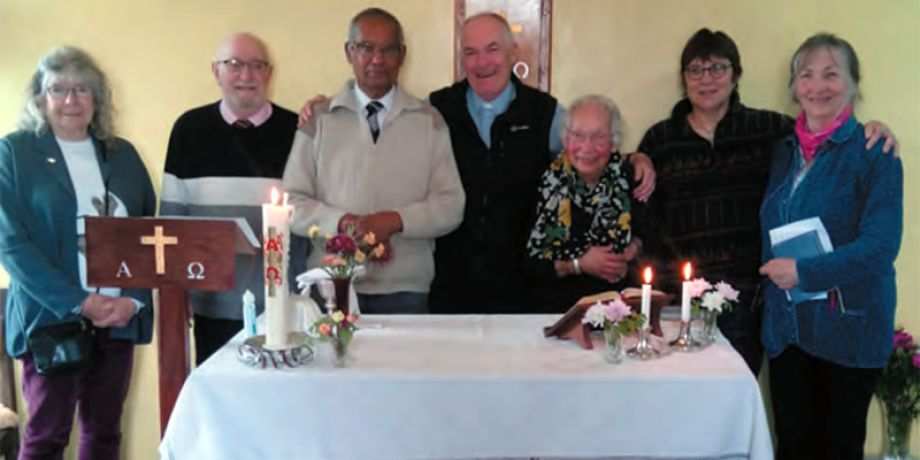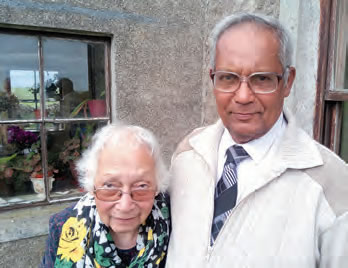
“A land lost in the mists of time” might reasonably describe Sanday, an eerily beautiful speck of land set in the Atlantic at the northern edge of Scotland’s Orkney Islands. Its strategic location astride ancient sea-lanes means it displays a wealth of archaeological remains, from Neolithic, Celtic and — most notably — Viking times.

Sanday is sparsely populated and few of its 500 inhabitants are Catholic. Remarkably, for many years the faith has been kept alive here by Columban supporters Maurice and Jean Soord. Even more remarkably, Maurice and Jean are not originally from the Orkneys, nor from England, nor Ireland, not even from Scotland … but from Myanmar (formerly Burma)!
Their story is as fascinating as that of Sanday itself. Both were born in Burma during the days of the British Raj. When Japan invaded in 1941 Maurice’s family opted to stay, but Jean’s decided to escape. They joined one of the last caravans making up the great trek over the foothills of the Himalayas into India. For most of the refugees this was a harrowing experience, but Jean’s only memory of it is a happy one. “I’d never seen snow before,” she told me. “It was wonderful. I remember making snowballs and throwing them at my brother.” They returned after the Liberation but fled again — this time to England — after the abortive military coup in 1947 which occurred during the chaotic runup to independence. “We were living right opposite the Administration Building,” Jean recalls. “We heard the shooting, and I ran to the balcony to watch what was happening, until Mum came and dragged me back.” These were the shots which killed Aung San, Burma’s first leader. His daughter, Aung San Suu Kyi, also became the country’s leader but in a cruel twist of fate, she currently languishes in prison following the latest military coup.
Maurice’s family came to England at the same time, and he began to make his way as an engineer and a keen amateur photographer. On meeting Jean, he was determined to give her the wedding he felt she deserved. Jean recounts how, “Maurice sold all his photographic equipment so we could have a honeymoon. We went to Torquay.” She proudly showed me the Torquay sugar spoon they’ve kept as a memento ever since.

Jean became an auxiliary nurse and Maurice rose to become a cabling inspector on the London Underground. Once they’d retired and their seven children had left home, they looked around for a rural place by the sea. “One day I was glancing at ‘Exchange and Mart’ and there it was, the perfect home,” Maurice told me. “Saville” was an imposing 18th century former seat of a Sanday laird. They decided to fly up. “It was the first time I’d flown,” added Jean. “I was scared on the plane. I filled out my will on arrival, got someone to sign it. Everyone on the airfield hought it was hilarious.” Despite the hair-raising journey, Jean fell in love with Saville as much as did Maurice. They bought it and moved in. They felt they were in paradise. However, there was only one thing was lacking: there was no Catholic church!
Undaunted, they gathered the other Catholic islanders about them and began organizing Celebrations of the Word. Soon, the priest on the main island of the Orkneys made them Eucharistic ministers. The bishop in far-off Bardeen heard about them. Impressed, he visited and granted permission for them to convert a room of their house into a chapel. Nowadays, they host Mass there whenever a priest can visit and, meanwhile, hold daily Eucharistic services, take communion to the sick and generally keep the faith alive. I’m one of those lucky priests who’s had the privilege of presiding Mass in this marvelous place. Celebrating Sunday on Sanday at Saville with the Soords makes a fittingly impressive mouthful.
The little congregation was eager to divulge more of the magic of the island to me. Its Neolithic tombs are world-famous, while Christianity came to the later Celtic Pictish inhabitants in the 7th century courtesy of Irish and Northumbrian monks. In 2011, in a house now owned by parishioners Wendy and Allan, a rare Pictish Christian stone was unearthed, featuring a cross on one side and Celtic spirals on the other. Pride of place goes to the Vikings, however. They conquered the Orkney Islands in the 9th century and Norway only formally ceded them to Scotland in 1472.
In 1991 a spectacular Viking find was made close to Saville when the remains of a boat burial were discovered. A Norse ship had been interred along with the bodies of three individuals and a hoard of ornaments, weapons and other treasures. In 1997, another boat burial excavation was featured on national television. One morning Maurice was surprised by people knocking on the kitchen door. “They were Tony Robinson’s ‘Time Team’ from the BBC. They’d stumbled on something important and were desperate to borrow my wheelbarrows.”
Funny how God works things out. Not only does He use these wonderful do-it-yourself missionaries Maurice and Jean to link together Burma, the Orkneys, the Columbans and the Vikings, but He also avails of their talents to keep the light of the Church shining on a windswept outpost in the cold North Atlantic.
Fr. John Boles is Regional Director of the Columbans in Britain.
Maurice and Jean Soord were born in Myanmar (formerly Burma) and came to Britain around 70 years ago. They live on Sanday in the Orkney Islands off the no the coast of Scotland. They are Eucharistic Ministers and long-time friends of the Columbans.